A small bird with a redhead, the Redheaded Bird is a fascinating creature that has long been shrouded in mystery. Though it is small and its numbers are few, this bird is anything but ordinary.
Its small size is matched by its unique coloration – a bright red head, a small yellow beak, and wings of deep brown. It’s often seen flitting through the treetops or perched atop branches in small family groups, these birds can quickly grab your attention with their vibrant hues.
The Redheaded Bird has many interesting qualities that make it a fascinating species to observe. Its small size allows it to be incredibly agile in the air, and its bright red head gives it the ability to blend into its environment while camouflaging itself against predators.
It also has an impressive vocal range and is known for its loud chirping sounds that can often be heard echoing through the trees
Birds with Red Heads
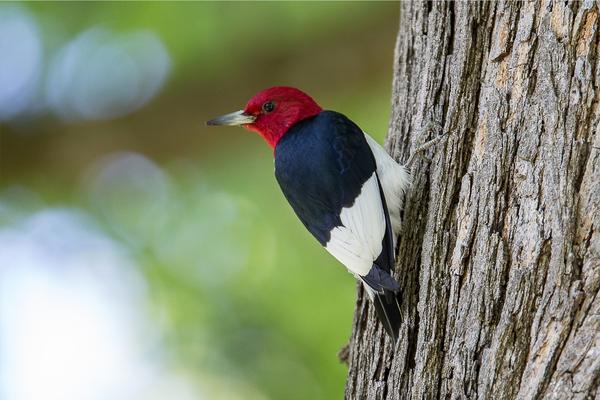
Red-headed birds are a beautiful sight in nature and bring to mind images of small, sprightly birds with striking features. A small bird with a prominent red head is instantly memorable, whether the body of the bird is yellow, grey, or beige.
Many small songbirds and finches don john crimson caps on their heads, feeding happily in small flocks and chirping away in a pleasant chorus.
Common birds that are actually known for their loud chirping may also have small touches of red feathers littering the top of their heads, barely noticeable until they angle certain ways in sunlight or flaunt it proudly when trying to attract mates.
The beauty of these red-headed feathered friends proves captivating and an excellent reason to get outside for a memorable morning walk.
House Finch
The small and energetic House Finch is a beautiful sight in North American gardens. Its bright red head and lack of fear of humans can make it a delightful companion in your backyard.
Mostly found in small flocks at bird feeders, this small bird’s adaptability to urban settings has made it one of the most common birds found throughout much of the United States.
Interestingly, when temperatures drop and food becomes scarce, the flock migrates to warmer regions.
This small finch is also an important host for the parasitic Cowbird, which lays its eggs in the nests of other small songbirds.
The species can be identified by its small size, conical bill, and streaked brown body with an orange-red face patch on adults. Interestingly, males tend to be brighter colored than females – producing quite a show for any birdwatching enthusiast!
Purple Finch

The purple finch is a small bird with a distinctly recognizable look. Its body is dull brown and white, but it’s its red face – along with its reddish beak and outlines around its eyes – that truly set it apart.
Native to parts of Canada and the United States, purple finches are generally small and robust, making them great backyard visitors when they flock together in small gatherings.
They’re particularly fond of small bushes and young trees where they can congregate while they feed on small insects or seeds from nearby plants.
In the late summer, you may get the chance to hear their unique song as they chirp away before preparing for migration later in the season.
Cassin’s Finch
Cassin’s Finch is a small bird, easily recognizable by its reddish-brown head cap. A small finch native to North America, vast numbers can be found in the western United States, from parts of Canada south through Central America.
The birds prefer open coniferous forests and montane woodlands for roosting and nesting, which may explain why they are more commonly seen in the mountains.
In addition to their distinctive coloring, Cassin’s Finches have conical-shaped bills adapted for crushing seeds and small insects.
With a wide-ranging diet, they are always on the lookout for food while they flit between branches. A social species, these small birds often cluster together in small flocks when migrating or taking part in group activities such as courtship.
Red Crossbill
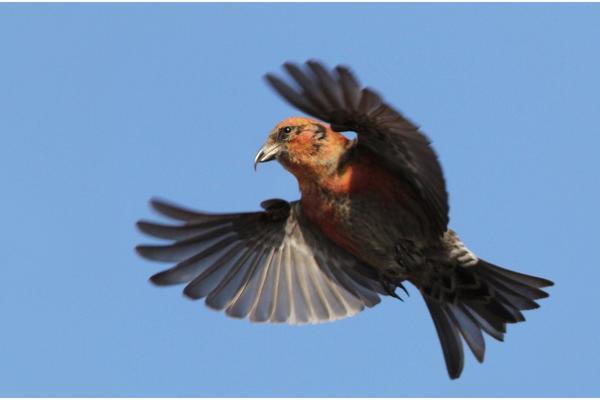
The enchanting Red Crossbill is a small bird with an unmistakable bright red head and wings of brownish-green, highlighted with small patches of yellow.
It can usually be found in coniferous forests across the northern US and in some parts of Canada, but these intelligent birds have been known to appear as far away as the coasts or even islands.
Due to their impressive skill at adaptability, the Red Crossbill diet consists of different types of seeds found on deciduous trees, conifers, and small farms.
Interestingly enough, its bill is used to help extract food from cones by crossed mandibles which gives it its ‘crossbill’ name. Its song can also be quite loud compared to similar-sized birds which makes them recognizable despite their small size.
Pine Grosbeak
The Pine Grosbeak is a small bird with a fiery redhead, native to the northern latitudes of North America and Eurasia. They can usually be found in pine woods, where their diet consists largely of buds, cones, fruits, sap, and seeds – making them important dispersers of seeds from various conifers.
Not much is known about the migration patterns of the Pine Grosbeak nor even its population size, though some findings indicate that it has experienced some decline in recent years. Despite this challenge, the small yet vibrant bird is sure to amaze observers wherever its plump form and beautiful plumage are seen!
Northern Cardinal

The Northern Cardinal is a small, beautiful bird that is recognized by its distinct red head, which stands out against its tan and green feathers. It is a popular backyard bird across much of the Eastern and Midwestern United States. They are quite social birds, often seen in small flocks in open woodlands, swamps, and urban gardens.
This small bird has an especially melodic song and territorial calls that can be heard in early spring. It also has one of the most common courtship behaviors among small birds: singing back and forth between mates.
Feeding the northern cardinal is not hard; it enjoys millet, sunflower seeds, and mealworms offered on platform feeders or in small cups. With some simple observations and effort to attract them to your garden, you can enjoy watching these small but delightfully colorful birds share their special presence with you throughout the year!
Pyrrhuloxia
Pyrrhuloxia is a small bird native to the deserts of Mexico and the southwestern United States. It has a unique feature that sets it apart from many other small birds – its head is covered in vivid red feathers! During mating season, the bright color turns even brighter, making it hard to ignore. These small birds call la Baja California home, but can also be found in Texas, Arizona, and New Mexico.
The diet of these small birds consists mainly of small insects supplemented by seeds, fruits, and grains from nearby vegetation. While their numbers aren’t rapidly increasing or decreasing, it is still important for us to pay attention to these small creatures so we can make sure their environment stays healthy and safe for them.
Summer Tanager
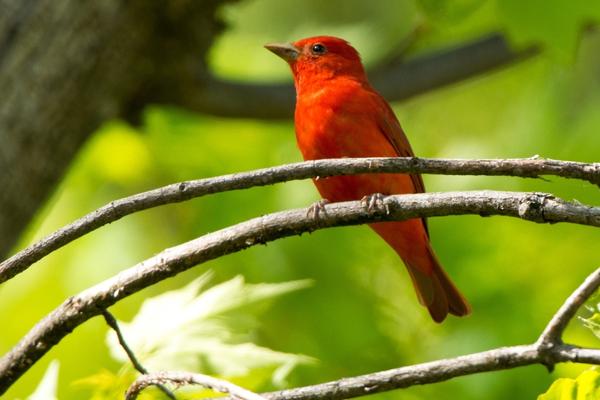
The Summer Tanager is a small bird that is distinctive in its bright redhead, with small tufts of yellow feathers at the base of the small crest.
This small bird can be found making delightful chirps and music across much of the eastern United States, often blending into stubbornly recessed tree branches where they can almost disappear in their camouflage if one isn’t careful.
Fortunately, if the small redhead gives them away, they are easily identifiable and while they may blend in with most environments, they make their presence known with their sweet melodies.
Western Tanager
The Western Tanager is a small bird that is well known for its striking redhead. The small size of this songbird makes it hard to find and even harder to appreciate its beauty.
With a wingspan of approximately 18 centimeters, the small but vibrant Western Tanager stands out amongst its peers for its bright yellow body and inky black wings tipped with white.
These birds are commonly found on the western coast of North America, often preferring a habitat of coniferous forests that provide not only a place to rest but also protection from their predators.
These small birds possess an impressive singing voice, considered similar in melody to canaries, adding further beauty to their woodland habitats.
Scarlet Tanager
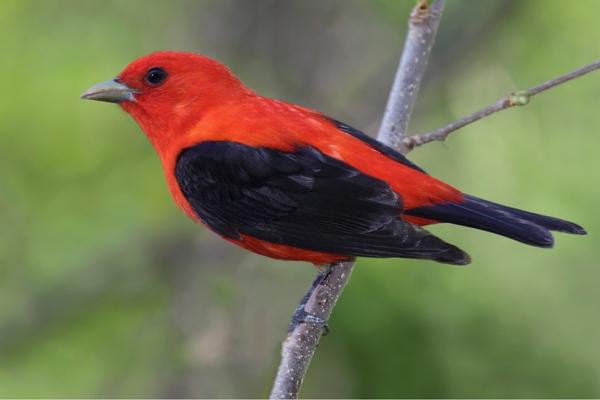
The Scarlet Tanager is a small bird with a strikingly attractive appearance. Its most prominent feature is its distinctively deep crimson head, neck, breast, and rump. Despite its small size, this small songbird stands out among other bird species due to its vibrant coloring.
Overshadowing the common brown tanagers found in America, it lives and breeds in deciduous woodlands eating small insects. It is important to respect the habitat of these small birds to ensure that their bright scarlet color can continue to populate our skies for years to come!
Vermilion Flycatcher
The Vermilion Flycatcher is a small migratory bird in the Tyrannidae family. It can be found across Mexico and in portions of the Southwest United States, from California to Texas.
This small bird has a characteristic bright red head with a greyish underside and it can often be seen perched on small man-made structures such as fences or small poles. They are also known for their distinct call, which consists of several sharp and metallic chirps or whistles that they use to communicate with one another.
Although they are small birds, Vermilion Flycatchers require well-managed habitat in order to thrive, making conservation efforts essential for their survival.
Red-headed Woodpecker

Red-headed woodpeckers are small birds with red heads, providing a beautiful and instantly recognizable contrast against the natural environment.
These small creatures can be found across North America, where they spend their time climbing trees, looking out for small insects, or drilling small cavities in order to store suet or other food sources during the winter months.
They build nests in these cavities as well, making them homes for a wide variety of bird species. Red-headed Woodpeckers also have an incredibly loud voice which is often used to alert members of the same species and warn away predators from taking over their territory.
Their behavior is truly remarkable, and watching them live their lives provides an exciting opportunity for birdwatchers everywhere.
Red-breasted Sapsucker
The Red-breasted Sapsucker is an incredibly small bird, but don’t let its small size fool you. Known for their striking redheads and black and white backsides, they are a stunning sight in the wild.
Found mainly in the western United States from northern Mexico up to Alaska, these birds nest in small cavities of trees and may form small family groups, making them great candidates for birdwatchers to observe.
From their small patches of vivid red feathers that adorn the top of their heads to their elongated beaks pointed specifically for sap, these small birds have many storied details worth observing.
Pileated Woodpecker
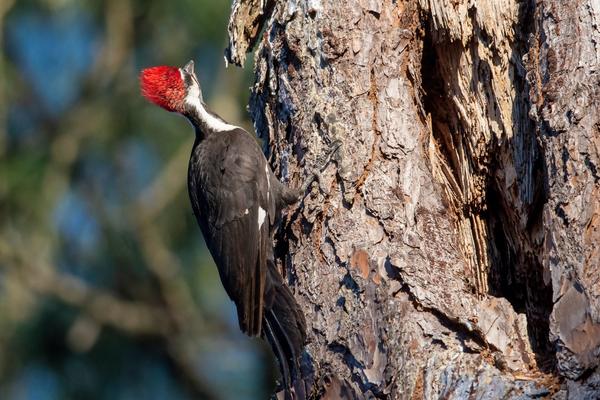
The Pileated Woodpecker is a small bird with a striking red head, black wings and body, and white stripes down its neck. They are native to North America and typically found in wooded areas where there are plenty of trees to drum upon and dig into for food.
The Pileated Woodpecker primarily feeds on insects living inside of dead or dying trees, breaking off pieces of bark to create holes similar to those of small volcanoes.
These small birds usually nest in abandoned woodpecker holes as well as natural cavities in mature trees, making sure that they’re near enough to their food source.
As fascinating as these small creatures are, the Pileated Woodpecker is considered ‘near threatened due to loss of suitable habitat from deforestation and climate change.
It’s important that humans make an effort to protect the environment so we can ensure this iconic small bird can thrive for years to come.
Red-bellied Woodpecker
The red-bellied woodpecker is a small, unique, and curious bird species that is widely distributed across the southeastern United States.
It has an unmistakable look thanks to its bright red head and chest, small size, and distinctive call. The diet of the red-bellied woodpecker consists of a wide variety of insects and small spiders as well as nuts and fruits.
In addition, this small bird often times feeds on suet or other specialty feeders for birds to supplement their diets. Despite its small size, the passionate energy with which it drums on trees is unmistakable, when it searches for food that might have found shelter in crevices or bark.
All in all, the Red-bellied Woodpecker is an interesting creature worth watching for hints of their wild behavior in natural settings.
Acorn Woodpecker
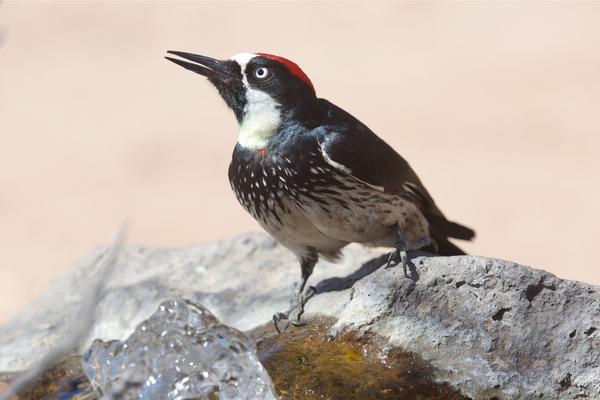
The Acorn Woodpecker is a small bird with an unmistakable look – a prominent red head atop a black body. Known for their impressive wood-pecking skills, these birds can be found from western North America to even the tip of Chile.
They feed off small insects, but what truly sets them apart is their use of oak trees to store acorns as food sources throughout the winter.
Equally fascinating is their penchant for living together in small groups, with each only retaining ownership of small parts of the tree they use to store their food.
All in all, the Acorn Woodpecker shows us that within small packages come unique and captivating features!
Downy Woodpecker
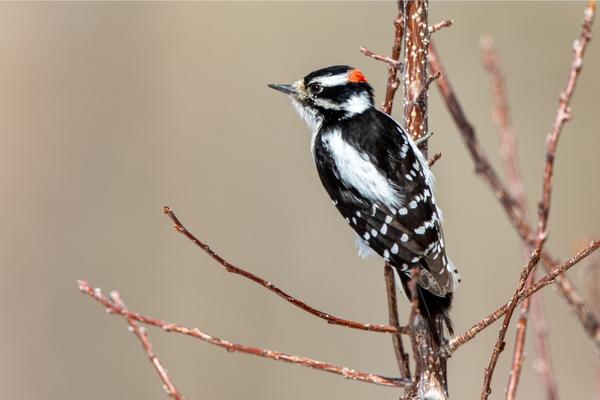
The Downy Woodpecker is a small bird that can be found in North America. It is easily identifiable by its small size and red-capped head. Often spotted on trunks of trees, these small birds have strong bills that enable them to bore out small holes in the search of insects.
A unique white spotting on the wings makes them even more appealing to watch. This small bird has a loud call, making it simple to locate! They are also frequent visitors of feeders, providing enjoyable entertainment for backyard bird watchers everywhere!
Conclusion
Small birds with red heads are a sight to behold. The Pileated Woodpecker, Red-bellied Woodpecker, Acorn Woodpecker, and Downy Woodpecker all make for great bird-watching candidates as they demonstrate their unique behaviors in the wild.
Whether it’s storing food for the winter or searching for small insects, these small birds with red heads provide hours of captivating entertainment.
What’s more is that they are all considered ‘near threatened due to climate change and deforestation, highlighting the importance of preserving natural habitats for small creatures such as these! Therefore, it’s important to make small efforts as individuals in order to protect these small birds with red heads and their environments for generations to come.




.jpg)